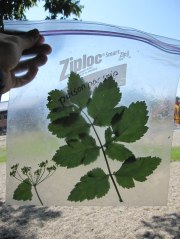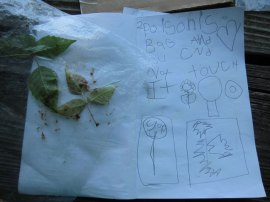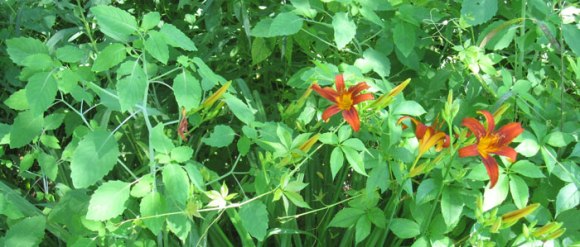Whether you are young or old, if you want to have positive experiences in nature, it’s good to know how to identify the poisonous and irritating plants in your region. If you work with kids outside, this is especially important! What do you see in the photo below?
 If kids or adults know their edibles (black cap berries) and encounter this scene, they may learn about poison ivy the hard way.
If kids or adults know their edibles (black cap berries) and encounter this scene, they may learn about poison ivy the hard way.
 Here’s how I help my groups of kids start to learn their Poisonous Plants:
Here’s how I help my groups of kids start to learn their Poisonous Plants:
Introducing……. The Poisonous Plant Guide!
1) Collect your specimens: Turn a gallon zip lock bag inside out and put it on your hand like a glove. Find your poisonous plant of choice. Break off a leaf, flower head, and/or any other parts you’d like your group to become familiar with. Turn the bag back inside-in, push out the air, and zip it shut.
 2) Create Poison Plant Guides: Have your group look at each specimen closely. Use magnifying glasses if you want! Draw and label each plant in your very own Poison Plant Guide. Help your young authors notice details such as jagged-edged leaves, the number of leaves are coming off of one stem, the colors of leaves and flowers, and other details.
2) Create Poison Plant Guides: Have your group look at each specimen closely. Use magnifying glasses if you want! Draw and label each plant in your very own Poison Plant Guide. Help your young authors notice details such as jagged-edged leaves, the number of leaves are coming off of one stem, the colors of leaves and flowers, and other details.
 3) Find Examples Growing: The best way to really learn to identify plants is to see them growing. With enough sightings, even very young kids can become experts in a growing season.
3) Find Examples Growing: The best way to really learn to identify plants is to see them growing. With enough sightings, even very young kids can become experts in a growing season.
4) HAVE FUN OUTSIDE! Now that your group knows what plants to avoid, there’s nothing to stop them from fully experiencing, playing, observing, and discovering the outsidoors in wild (and not so wild) places.
5) Don’t stop with poisonous and irritating plants. Once kids start getting the hang of identifying plants, add edible and healing plants to your guide!
